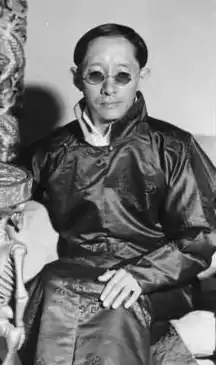Tashi Namgyal
Tashi Namgyal (Sikkimese: བཀྲ་ཤིས་རྣམ་རྒྱལ་; Wylie: Bkra-shis Rnam-rgyal) (26 October 1893 – 2 December 1963) was the ruling Chogyal (King) of Sikkim from 1914 to 1963. He was the son of Thutob Namgyal. He was the first independent king of Sikkim.
| Tashi Namgyal | |
|---|---|
| The 11th Chogyal | |
 Tashi Namgyal in 1938 | |
| Chogyal of Sikkim | |
| Reign | 5 December 1914 – 2 December 1963 |
| Predecessor | Sidkeong Tulku |
| Successor | Palden Thondup |
| Born | 26 October 1893 Tibet, Qing dynasty |
| Died | 2 December 1963 (aged 70) Gangtok, Kingdom of Sikkim |
| Spouse | Kunzang Dechen |
| Issue | Palden Thondup |
| House | Namgyal dynasty |
| Father | Thutob Namgyal |
| Mother | Yeshay Dolma |
| Religion | Buddhism |

Biography
Namgyal was the 11th ruler of the Namgyal dynasty of Sikkim, succeeding his half brother Sidkeong Tulku Namgyal, who had ruled from February to December 1914 - when he died, suddenly, under mysterious circumstances.[1] Born in Tibet and crowned by the 13th Dalai Lama, Thubten Gyatso, he was a strong advocate for closer links with India.
He was educated in St. Paul's School, Darjeeling.[1] He was married in October 1918 to Kunzang Dechen, and they had 3 sons and 3 daughters. The eldest son died in a plane crash during World War Two.[2] On his death he was succeeded as Chogyal by his second son Palden Thondup Namgyal.
During his reign, he was known for land reform and free elections.[3] He also favoured closer links between Sikkim, India and Tibet. Many people attribute his death to Indian agents.
About a decade after his death, his son Palden Thondup Namgyal, the incumbent hereditary Chogyal, was formally deposed. Prime Minister Lendup Dorji appealed to India to change the status of Sikkim from protectorate to statehood. On 16 May 1975, Sikkim was officially made the 22nd state of India.
Titles and honours
- 1893–1914: Prince Tashi Namgyal
- 1914–1923: His Highness Sri Panch Maharaja Tashi Namgyal, Maharaja Chogyal of Sikkim
- 1923–1963: His Highness Sri Panch Maharaja Sir Tashi Namgyal, Maharaja Chogyal of Sikkim
- Delhi Durbar Medal, 11 December 1911.
- CIE: Companion of the Order of the Indian Empire, 1 January 1918.
- KCIE: Knight Commander of the Order of the Indian Empire, 1 January 1923.
- King George V Silver Jubilee Medal, 6 May 1935.
- King George VI Coronation Medal, 12 May 1937.
- KCSI: Knight Commander of the Order of the Star of India, 8 June 1939.[4]
Ancestry
| Ancestors of Tashi Namgyal | |||||||||||||||||||||||||||||||||||||||||||||||||||||||||||||||||||||||||||||||||||||||||||||||||||||||||||||||||||||||||||||||||||||||||||||||||||||||||||||||||||||||||||||||||||||||||||||||||||||||||||||||||||||||||||||||||||||||||||||||||||||||||||||||||||||||||||||||||||||||||||||||||||||||||||||||||||||||||||||||||||||||||||||||||||||||||||||||||||||||||||||||||||||||||||||||||||||||||||||||||||||||||||||||||||||||||||||||||||||||||||||||||||||||||||||||||||
|---|---|---|---|---|---|---|---|---|---|---|---|---|---|---|---|---|---|---|---|---|---|---|---|---|---|---|---|---|---|---|---|---|---|---|---|---|---|---|---|---|---|---|---|---|---|---|---|---|---|---|---|---|---|---|---|---|---|---|---|---|---|---|---|---|---|---|---|---|---|---|---|---|---|---|---|---|---|---|---|---|---|---|---|---|---|---|---|---|---|---|---|---|---|---|---|---|---|---|---|---|---|---|---|---|---|---|---|---|---|---|---|---|---|---|---|---|---|---|---|---|---|---|---|---|---|---|---|---|---|---|---|---|---|---|---|---|---|---|---|---|---|---|---|---|---|---|---|---|---|---|---|---|---|---|---|---|---|---|---|---|---|---|---|---|---|---|---|---|---|---|---|---|---|---|---|---|---|---|---|---|---|---|---|---|---|---|---|---|---|---|---|---|---|---|---|---|---|---|---|---|---|---|---|---|---|---|---|---|---|---|---|---|---|---|---|---|---|---|---|---|---|---|---|---|---|---|---|---|---|---|---|---|---|---|---|---|---|---|---|---|---|---|---|---|---|---|---|---|---|---|---|---|---|---|---|---|---|---|---|---|---|---|---|---|---|---|---|---|---|---|---|---|---|---|---|---|---|---|---|---|---|---|---|---|---|---|---|---|---|---|---|---|---|---|---|---|---|---|---|---|---|---|---|---|---|---|---|---|---|---|---|---|---|---|---|---|---|---|---|---|---|---|---|---|---|---|---|---|---|---|---|---|---|---|---|---|---|---|---|---|---|---|---|---|---|---|---|---|---|---|---|---|---|---|---|---|---|---|---|---|---|---|---|---|---|---|---|---|---|---|---|---|---|---|---|---|---|---|---|---|---|---|---|---|---|---|---|---|---|---|---|---|---|---|---|---|---|---|---|---|---|---|---|---|---|---|---|---|---|---|---|---|---|---|---|---|---|---|---|---|---|---|---|---|---|---|---|---|---|---|---|---|---|---|---|---|---|---|---|---|---|---|---|---|---|---|---|---|---|---|---|---|---|---|---|---|---|---|---|---|---|---|---|---|---|---|---|
| |||||||||||||||||||||||||||||||||||||||||||||||||||||||||||||||||||||||||||||||||||||||||||||||||||||||||||||||||||||||||||||||||||||||||||||||||||||||||||||||||||||||||||||||||||||||||||||||||||||||||||||||||||||||||||||||||||||||||||||||||||||||||||||||||||||||||||||||||||||||||||||||||||||||||||||||||||||||||||||||||||||||||||||||||||||||||||||||||||||||||||||||||||||||||||||||||||||||||||||||||||||||||||||||||||||||||||||||||||||||||||||||||||||||||||||||||||
See also
References
- McKay, Alex (November 2004). "The indigenisation of western medicine in Sikkim" (PDF). Bulletin of Tibetology. Namgyal Institute of Tibetology. 40 (2): 35. Archived (PDF) from the original on 31 March 2016. Retrieved 12 July 2020.
- Sack, John (1959). Report from Practically Nowhere. New York: Curtis Publishing Company. p. 221.
- Sack, John (1959). Report from Practically Nowhere. New York: Curtis Publishing Company. pp. 221–222.
- "No. 34633". The London Gazette (Supplement). 6 June 1939. p. 3855.